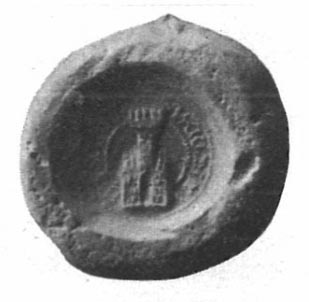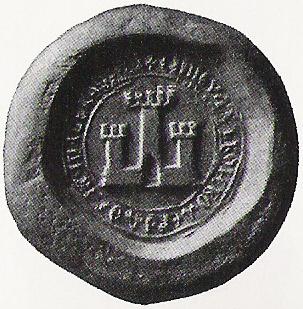
Stephen Tvrtko I was the first king of Bosnia. A member of the House of Kotromanić, he succeeded his uncle Stephen II as the ban of Bosnia in 1353. As he was a minor at the time, Tvrtko's father, Vladislav, briefly ruled as regent, followed by Tvrtko's mother, Jelena. Early in his personal rule, Tvrtko quarrelled with his country's Roman Catholic clergy but later enjoyed cordial relations with all the religious communities in his realm. After initial difficulties—the loss of large parts of Bosnia to his overlord, King Louis I of Hungary, and being briefly deposed by his magnates—Tvrtko's power grew considerably. He conquered some remnants of the neighbouring Serbian Empire in 1373, after the death of its last ruler and his distant relative, Uroš the Weak. In 1377, he had himself crowned king of Bosnia and Serbia, claiming to be the heir of Serbia's extinct Nemanjić dynasty.

Visoko is a city located in the Zenica-Doboj Canton of the Federation of Bosnia and Herzegovina, an entity of Bosnia and Herzegovina. As of 2013, the municipality had a population of 39,938 inhabitants with 11,205 living in Visoko town. Located between Zenica and Sarajevo, Visoko lies where the river Fojnica joins the Bosna.

The Republic of Ragusa was an aristocratic maritime republic centered on the city of Dubrovnik in South Dalmatia that carried that name from 1358 until 1808. It reached its commercial peak in the 15th and the 16th centuries, before being conquered by Napoleon's French Empire and formally annexed by the Napoleonic Kingdom of Italy in 1808. It had a population of about 30,000 people, of whom 5,000 lived within the city walls. Its motto was "Non bene pro toto libertas venditur auro", a Latin phrase which can be translated as "Liberty is not well sold for all the gold".

The area of today's Visoko is considered to be a nucleus from where Bosnian statehood was developed in 10th century. The expanded valley of the river Bosna around today's Visoko was the biggest agriculture area in central Bosnia, so fertile ground around Visoko was ideal for development of early political center of Bosnian nobility.

The House of Kosača, somewhere Kosačić, was a Bosnian medieval noble family which ruled over parts of modern-day Bosnia and Herzegovina, Croatia, Montenegro, and Serbia between the 14th century and the 15th century. The land they controlled was known as Humska zemlja, roughly corresponding to modern region of Herzegovina, which itself was derived from the title "Herzog", which Stjepan Vukčić Kosača adopted in 1448., with latin title "Dux Sancti Sabbae". Besides Hum, they ruled parts of Dalmatia and Rascia. They were vassals to several states, including the Kingdom of Bosnia and Ottoman Empire. Historians think the Kosača family is part of the Kőszegi family, but there is a lack of evidence for this claim.
The religious confession of the Kosača family is uncertain. They were in contact with the Eastern Orthodox Church, the Church of Bosnia, the Roman Catholic Church and Islam. During the fall of the Bosnian Kingdom, the "Kosače" split into three branches: Venetian, Dalmatian and Ottoman. From then onward, these branches became accepting of the Roman Catholic faith, in the first two cases, and of Islam in the third.

Herzegovina is the southern and smaller of two main geographical regions of Bosnia and Herzegovina, the other being Bosnia. It presently does not have strictly defined administrative borders; however, in the past it was organized as Sanjak of Herzegovina and Herzegovina Eyalet (1833–1851).

The Banate of Bosnia, or Bosnian Banate, was a medieval state located in what is today Bosnia and Herzegovina. Although Hungarian kings viewed Bosnia as part of Hungarian Crown Lands, the Banate of Bosnia was a de facto independent state for most of its existence. It was founded in the mid-12th century and existed until 1377 with interruptions under the Šubić family between 1299 and 1324. In 1377, it was elevated to a kingdom. The greater part of its history was marked by a religiopolitical controversy revolving around the native Christian Bosnian Church condemned as heretical by the dominant Chalcedonian Christian churches, namely the Catholic and Eastern Orthodox churches, with the Catholic Church being particularly antagonistic and persecuting its members through the Hungarians.

The Kingdom of Bosnia, or Bosnian Kingdom, was a medieval kingdom that lasted for nearly a century, from 1377 to 1463, and evolved out of the Banate of Bosnia, which itself lasted since at least 1154.

The House of Pavlović, also Radinović or Radenović, or Radinović-Pavlović, was Bosnian noble family who got their name after Radin Jablanić. Radin's father, Jablan, was a founder of Jablanić house, an earlier branch of this medieval Bosnian clan. Jablan's estate was in Jablan village. Later, family extended their feudal possessions from the Middle and Upper Drina river in the eastern parts of medieval Bosnia, known as Pavlovića zemlja, to south-southeastern regions of the Bosnian realm in Hum and Konavle at the Adriatic coast. The family official residence and seat was at Borač and later Pavlovac, above the Prača river canyon, between present-day Prača, Rogatica and Goražde in Bosnia and Herzegovina.

Pavle Radinović, sometimes Radenović,, was one of the most powerful Bosnian nobleman under Tvrtko I, Dabiša, Jelena Gruba, Ostoja, Tvrtko II and Ostoja again. He was a knez and the head of Radinović-Pavlović noble family, a powerful magnate clan whose initially possessions spread from central to eastern Bosnia, gravitating around the Prača - Miljacka river axis, between the Krivaja Drina and the Upper Bosna rivers, with the seat in Borač and Pavlovac between Prača and Rogatica, and also held mines in Olovo and Fojnica.

Vlachs in medieval Bosnia and Herzegovina were a Western Balkans population descending from a mixture of Romanized pre-Slavic Romance-speaking peoples and the South Slavs. From the 14th century the ethnic meaning of term "Vlach" was replaced with societal meaning and often meant the Slavic population with similar lifestyle. They practiced transhumance as herdsmen, shepherds, farmers, and in time developed peculiar socio-political organizational units known as katuns. With their caravans, Vlach carried out much of the traffic between Bosnian inland and coastal cities such as Dubrovnik. They also had close contacts and militarily served various Bosnian noble families and kings.
Vrsinje was a medieval župa, at times part of the Kingdom of Serbia, the Kingdom of Bosnia, and briefly, as a nahiya of the Ottoman Empire. It was a county in the land of Travunija. After the Ottoman conquest, it was replaced by the Zupci.

Mile is archaeological medieval site located in the Visoko basin, in present day Arnautovići village near Visoko, Bosnia and Herzegovina. The site was a medieval crowning and burial church of Bosnian kings during the Bosnian Banate and later Kingdom, between its construction in 1340 and the fall of the Kingdom in 1463.

Pavao Anđelić (1920-1985) was a Bosnian Croat and Yugoslav lawyer, archaeologist and historian. He mainly studied the history of medieval Bosnia and is noted for archeological work done at Mile and historically rich areal surrounding modern town of Visoko, as well as Kraljeva Sutjeska and Bobovac.

The Humska Zemlja, also Hum, is a historical zemlja that arose in the Middle Ages as well-defined administrative unit of medieval Bosnia ruled by the Kosača dynasty. It included most of today's Herzegovina, in Bosansko Primorje including Konavle, territories on the south of Dalmatia between Omiš and Neretva Delta, in Boka Kotorska and south to Budva. The name for this zemlja derived from the earlier name for the region, Zahumlje. The seat of Kosače family was in the town and fortress of Blagaj and during the winter seasons, Novi.
The Pribinić family, also Radosalić family or Radosalić–Pribinić family, were a prominent medieval Bosnian noble family, a holder of the hereditary honor, which ruled over the medieval župa of Lepenica, a part of the medieval Bosnian state. Župa Lepenica was located in central Bosnia and included modern day's towns of Kiseljak, Fojnica and Kreševo. The Lepenica was mentioned for the first time in 1244 in the charter of the Hungarian king Bela IV, along with other parishes that existed in the area of central Bosnia.

Bosansko Primorje is a historical coastal region on the eastern Adriatic shores, which between the beginning of the 14th and the end of the 17th century stretched from the Neretva river delta to Kuril area of Petrovo Selo, near today's Dubrovnik, above Mokošica in Rijeka Dubrovačka. This region is referred in historiography as the Bosansko Primorje, Bosnian Littoral or Bosnian Coast.

Petar I Pavlović was a knez, and then a Grand Duke of Bosnia, from the noble family of Pavlović, which had its possessions in the eastern parts of the Kingdom of Bosnia. After the murder of his father Pavle Radinović on Parena Poljana near royal court in Sutjeska and below a Bobovac in 1415, after the stanak at which whole Pavlović family was present at, Petar took over the leadership of the Pavlovići and with his younger brother Knez Radosav (1420–1441) started a war against Sandalj Hranić (1392–1435) and Kosača klan. In that conflict, he relied on the help of the Ottomans, whose help he paid for by recognizing vassal relations to the sultan, which also resulted in successful campaigns against Sandalj, who was completely suppressed. However, the Ottomans changed sides and arrived in the Kingdom of Bosnia in 1420 as Sandalj's allies against Pavlović. In the conflict with them, Petar himself was killed, and his younger brother Radosav succeeds him as the leader of Pavlović and the Grand Duke of Bosnia.

The Pavlovićs' Zemlja,, is a historical zemlja that arose in the Middle Ages as well-defined administrative unit of medieval Bosnia ruled by the Pavlović dynasty. It included most of today's eastern Bosnia, and some territories on the south of the country, around Trebinje, in Bosansko Primorje and in Konavle. The name of Pavlović land is taken from the patronymic, which was borne by two generations of Pavle Radinović's descendants and administrative sub-division term "zemlja". The seat of Pavlović family was in the town and fortress of Borač and later nearby Pavlovac, which were both located on the left bank of the river Prača, between Mesići and Prača.
















